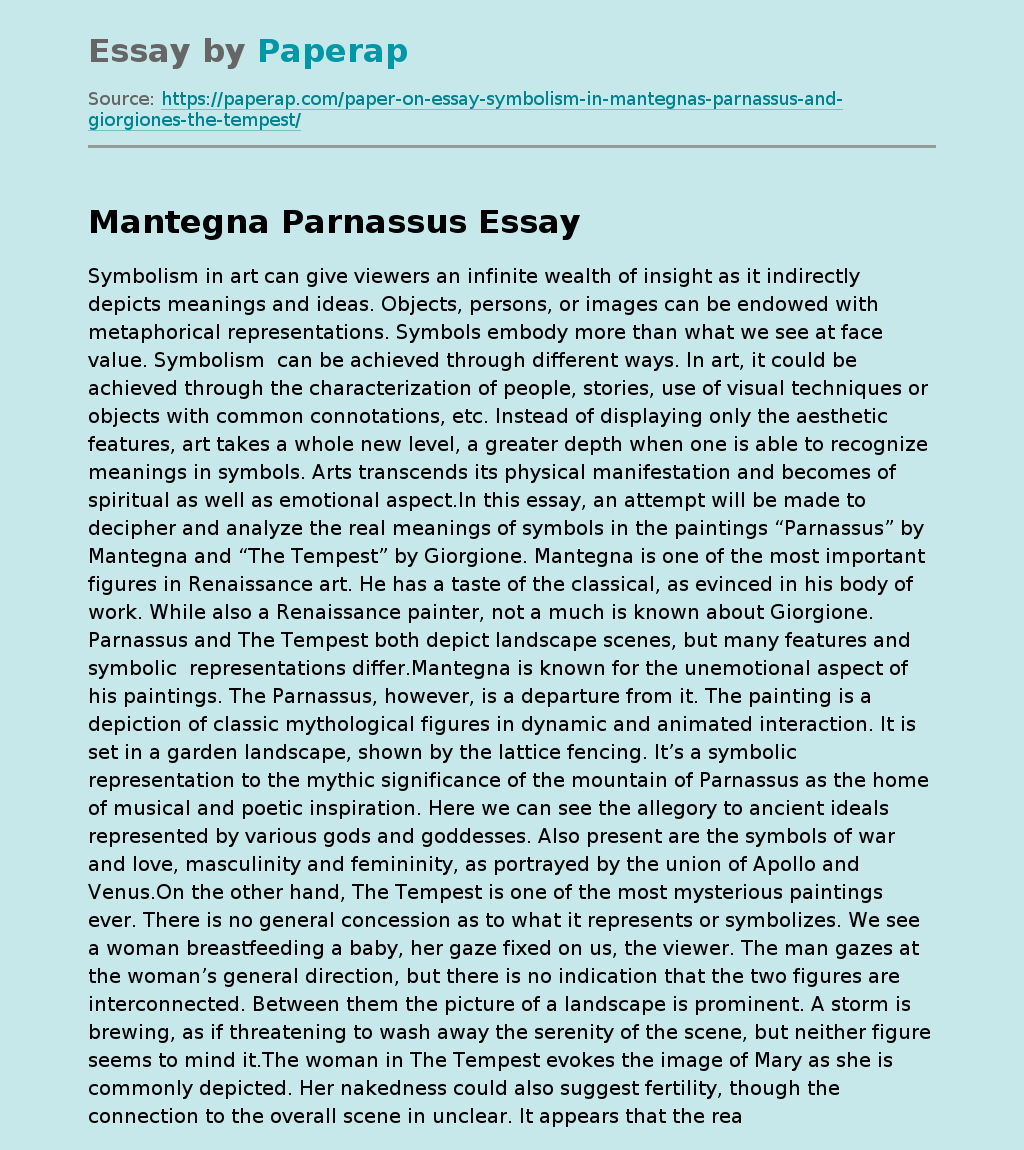Mantegna Parnassus
Symbolism in art can give viewers an infinite wealth of insight as it indirectly depicts meanings and ideas. Objects, persons, or images can be endowed with metaphorical representations. Symbols embody more than what we see at face value. Symbolism can be achieved through different ways. In art, it could be achieved through the characterization of people, stories, use of visual techniques or objects with common connotations, etc. Instead of displaying only the aesthetic features, art takes a whole new level, a greater depth when one is able to recognize meanings in symbols.
Arts transcends its physical manifestation and becomes of spiritual as well as emotional aspect.In this essay, an attempt will be made to decipher and analyze the real meanings of symbols in the paintings “Parnassus” by Mantegna and “The Tempest” by Giorgione. Mantegna is one of the most important figures in Renaissance art. He has a taste of the classical, as evinced in his body of work. While also a Renaissance painter, not a much is known about Giorgione.
Parnassus and The Tempest both depict landscape scenes, but many features and symbolic representations differ.Mantegna is known for the unemotional aspect of his paintings. The Parnassus, however, is a departure from it. The painting is a depiction of classic mythological figures in dynamic and animated interaction. It is set in a garden landscape, shown by the lattice fencing. It’s a symbolic representation to the mythic significance of the mountain of Parnassus as the home of musical and poetic inspiration.
Here we can see the allegory to ancient ideals represented by various gods and goddesses. Also present are the symbols of war and love, masculinity and femininity, as portrayed by the union of Apollo and Venus.On the other hand, The Tempest is one of the most mysterious paintings ever. There is no general concession as to what it represents or symbolizes. We see a woman breastfeeding a baby, her gaze fixed on us, the viewer. The man gazes at the woman’s general direction, but there is no indication that the two figures are interconnected. Between them the picture of a landscape is prominent. A storm is brewing, as if threatening to wash away the serenity of the scene, but neither figure seems to mind it.The woman in The Tempest evokes the image of Mary as she is commonly depicted. Her nakedness could also suggest fertility, though the connection to the overall scene in unclear. It appears that the real meaning of this work is elusive. The meaning, it seems, lies in what the viewer can make of it. Unlike the Parnassus, any recognizable visual allusion in The Tempest is not readily depicted. Both paintings portray naked women, but the woman nursing a baby in The Tempest can be viewed as being a fertility figure, as opposed to Venus is Parnassus, being the goddess of love is characterized with an erotic nature. While, the gods, and goddesses play as the prominent subject in Parnassus, the man and woman in The Tempest does not seem to be the most significant aspect of the painting. The landscape is a prominent feature, instead of serving as a background. It is suggested that Giorgione does not really have a subject, that the painting is done for it’s own sake and should be taken as a whole.Each viewer can apply his own meaning depending on a myriad of factors—this includes the societal context, culture, and personal experience. Some meanings can be ambiguous. Art in itself do not represent a single interpretation, but many objects can represent universal ideals. Indeed, an attempt to evaluate and decipher a symbolic form in paintings could also tell us much about the painter and his time. By the same token, that endeavor could also reflect our own time, our values and how it fares against the present context. In the absence of an outright symbolic representation, a painting’s meaning is ultimately dictated by our own.
Mantegna Parnassus. (2019, Dec 05). Retrieved from https://paperap.com/paper-on-essay-symbolism-in-mantegnas-parnassus-and-giorgiones-the-tempest/

